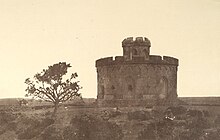
Bahadur Shah II, usually referred to by his poetic title Bahadur Shah Zafar was born Mirza Abu Zafar Siraj-ud-din Muhammad and was the twentieth and last Mughal Emperor of India as well as an Urdu poet. He was the second son and the successor to his father, Akbar II, who died on 28 September 1837. He was a titular Emperor, as the Mughal Empire existed in name only and his authority was limited only to the walled city of Old Delhi (Shahjahanbad). Following his involvement in the Indian Rebellion of 1857, the British exiled him to Rangoon in the British-controlled Burma in 1858, after convicting him on several charges.

The Indian Rebellion of 1857 was a major uprising in India in 1857–58 against the rule of the British East India Company, which functioned as a sovereign power on behalf of the British Crown. The rebellion began on 10 May 1857 in the form of a mutiny of sepoys of the Company's army in the garrison town of Meerut, 40 mi (64 km) northeast of Delhi. It then erupted into other mutinies and civilian rebellions chiefly in the upper Gangetic plain and central India, though incidents of revolt also occurred farther north and east. The rebellion posed a military threat to British power in that region, and was contained only with the rebels' defeat in Gwalior on 20 June 1858. On 1 November 1858, the British granted amnesty to all rebels not involved in murder, though they did not declare the hostilities to have formally ended until 8 July 1859. Its name is contested, and it is variously described as the Sepoy Mutiny, the Indian Mutiny, the Great Rebellion, the Revolt of 1857, the Indian Insurrection, and the First War of Independence.
Events in the year 1857 in India.

The Red Fort or Lal Qila is a historic fort in the Old Delhi neighbourhood of Delhi, India, that historically served as the main residence of the Mughal emperors. Emperor Shah Jahan commissioned construction of the Red Fort on 12 May 1638, when he decided to shift his capital from Agra to Delhi. Originally red and white, its design is credited to architect Ustad Ahmad Lahori, who also constructed the Taj Mahal. The fort represents the peak in Mughal architecture under Shah Jahan and combines Persianate palace architecture with Indian traditions.

Kamala Nehru was an Indian independence activist and the wife of Jawaharlal Nehru, the first Prime Minister of India. Her daughter Indira Gandhi was the first female Prime Minister of India.

General Bakht Khan (1797–1859) was the commander-in-chief of the Indian rebel forces in the city of Delhi during the Indian Rebellion of 1857 against the East India Company.

Kamla Nagar is a residential and commercial neighbourhood in North Delhi, India. It is one of Delhi's major shopping centres.
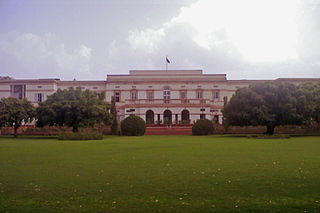
The Teen Murti Bhavan was built by British as the residence New Delhi of the Prime Minister of India, Jawaharlal Nehru. He stayed there for 16 years until his death on 27 May 1964. It was designed by Robert Tor Russell, the British architect of Connaught Place and of the Eastern and Western Courts on Janpath during the British Raj. Teen Murti Bhavan was built in 1930 as part of the new imperial capital of India, New Delhi as the residence of the Commander-in-Chief of the British Indian Army.
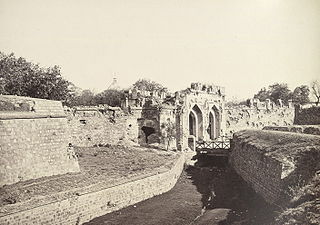
The siege of Delhi was one of the decisive conflicts of the Indian Rebellion of 1857.
Danapur Cantonment or Danapur Cantt is a cantonment town in Patna District in the state of Bihar, India. Danapur is a category II cantonment, established in 1765. The board consists of 14 members including 7 elected members. Danapur Cantonment, located on the outskirts of Patna, is the second oldest cantonment in India, after Barrackpur Cantonment, West Bengal. Danapur is the regimental centre of the Bihar Regiment (BRC). It was earlier called Bankipore Cantonment. Initially, it was set up at Bankipore but later set up in the Danapur area in 1766–67.

Vellore Fort is a large 16th-century fort situated in heart of the Vellore city, in the state of Tamil Nadu, India built by Vijayanagara kings. The fort was at one time the headquarters of the Aravidu Dynasty of the Vijayanagara Empire. The fort is known for its grand ramparts, wide moat and robust masonry.

Delhi Ridge, sometimes simply called The Ridge, is a ridge in the Northern Aravalli leopard wildlife corridor in the National Capital Territory of Delhi in India. It is a northern extension of the ancient Aravalli Range, some 1.5 billion years old. The ridge consists of quartzite rocks and extends from the southeast at Tughlaqabad, near the Bhatti mines, branching out in places and tapering off in the north near Wazirabad on the west bank of the river Yamuna, covering about 35 kilometres.
The Battle of Badli-ki-Serai was fought early in the Indian Rebellion of 1857, or First War of Indian Independence as it has since been termed in Indian histories of the events. A British and Gurkha force defeated a force of sepoys who had rebelled against the British East India Company. The British victory allowed them to besiege and ultimately capture Delhi.
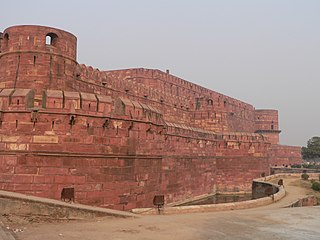
The Battle of Agra was a comparatively minor but nevertheless decisive action at the end of a prolonged siege during the Indian Rebellion of 1857.

The Mutiny Memorial, now known as Ajitgarh, is a memorial situated on the Ridge New Delhi. It was built in memory of all those who had fought in the Delhi Field Force, British and Indian, during the Indian Rebellion of 1857.
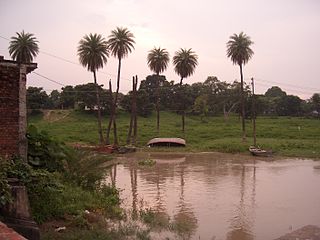
Satti Chaura Ghat or Massacre Ghat is a famous ghat in Kanpur, the industrial hub of Uttar Pradesh state in north India. It is located on the bank of the River Ganges in Kanpur Cantonment near Jajmau.
For other places with the same name, see Wazirabad (disambiguation)

Asigarh Fort, also called Hansi Fort, is located on the eastern bank of Amti lake in Hansi city of Haryana, India, about 135 km from Delhi on NH9. Spread over 30 acres, in its prime days this fort used to be in control of 80 forts in the area around it. The fort is said to be one of the most impregnable forts of ancient India and has been declared a centrally protected monument by ASI in 1937.
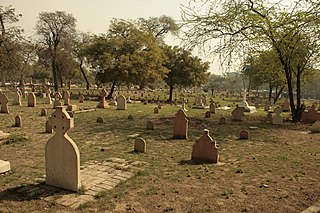
Nicholson Cemetery, formerly known as the Old Delhi Military Cemetery and the Kashmere Gate Cemetery, is a Christian cemetery located in Kashmere Gate, Delhi, India. It is located near the Kashmere Gate Metro Station and west of the Inter State Bus Terminal. It is the site of the earliest known Christian burials in Delhi NCR. The cemetery was established in 1857 and is named after Brigadier-General John Nicholson, a Victorian era military officer who played a pivotal role during the Indian Rebellion of 1857. The St. James' Church, who owns the cemetery, is the oldest place of worship for the Christian community of Delhi. The church along with cemetery, St. Stephen's hostel, and the Victorian era houses of Kashmere Gate neighbourhood were once considered to be a "centripetal" part of Christians in Delhi.
Northern Ridge biodiversity park, in Delhi Ridge of Aravalli range is a 87 hectares biodiversity area in the Northern Ridge in Delhi, India. It lies in the Northern Aravalli leopard wildlife corridor.

